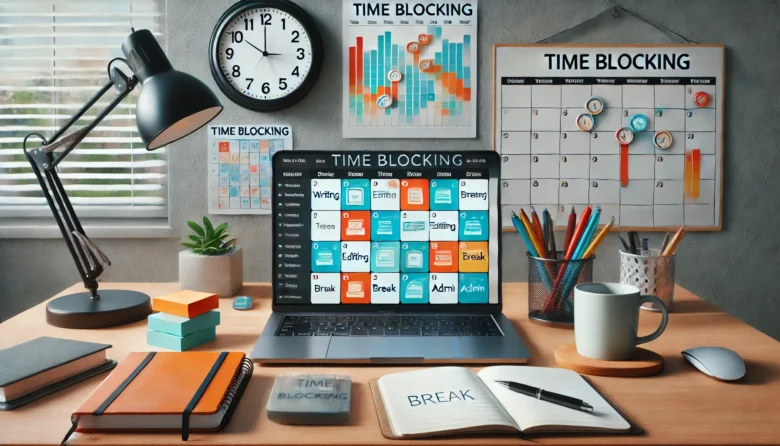If you’ve ever reached the end of a day feeling like you worked non-stop but got very little done, you’re not alone. As a freelance writer, juggling multiple tasks without structure can lead to scattered focus and burnout. One powerful solution? Time blocking.
In this article, you’ll learn how time blocking works, why it’s so effective for freelance writers, and how to build a time-blocked schedule that helps you write more, stress less, and stay in control.
What Is Time Blocking?
Time blocking is a productivity method where you divide your day into dedicated chunks of time—blocks—and assign specific tasks to each block.
Instead of working reactively, jumping from task to task, you work intentionally. Every hour of your day has a clear purpose.
Think of it as creating appointments with your most important work.
Why Time Blocking Works for Freelancers
Freelancers often struggle with:
- No fixed schedule
- Too many distractions
- Mixing admin, writing, and meetings randomly
- Underestimating how long tasks take
Time blocking solves this by:
- Giving structure to your day
- Creating space for deep work
- Helping you protect time for what matters most
- Preventing “task overflow” and overbooking
It’s especially effective for writers, who need large chunks of uninterrupted focus.
Step 1: Audit Your Tasks and Time
Before you can create time blocks, you need to understand:
- What you do every day
- How long each task actually takes
For 3–5 days, track your time:
- Writing
- Research
- Editing
- Admin (emails, invoices, etc.)
- Calls/meetings
- Breaks
- Personal tasks
Use a simple spreadsheet, notebook, or an app like Toggl Track.
Step 2: Group Tasks by Category
Group your tasks into categories like:
- Deep Work: writing, outlining, editing
- Admin: emails, invoicing, file management
- Client Communication: calls, follow-ups
- Content Planning: brainstorming, outlining
- Learning: courses, reading, skill-building
You’ll assign time blocks for each category later.
Step 3: Build Your Ideal Week Template
Now map out your week with dedicated blocks for each category.
Here’s an example for a freelance writer:
Monday–Friday:
| Time | Task |
|---|---|
| 8:00–8:30 | Morning routine + planning |
| 8:30–10:30 | Deep writing (Client work) |
| 10:30–10:45 | Break |
| 10:45–12:00 | Writing session #2 (Blog or LinkedIn content) |
| 12:00–1:00 | Lunch & rest |
| 1:00–2:00 | Editing + research |
| 2:00–2:30 | Emails + client follow-ups |
| 2:30–3:30 | Admin tasks or second deep work block |
| 3:30–4:00 | Wrap up + plan tomorrow |
Adjust based on your peak energy times and client needs.
Step 4: Use a Digital Calendar to Block Time
Use Google Calendar, Outlook, or tools like Sunsama or Motion to create your time blocks. Treat them like appointments:
- Give each block a specific task name
- Color-code your categories (e.g., writing = blue, admin = red)
- Set reminders or alerts to transition smoothly
Bonus tip: Leave buffer time between blocks in case tasks run over.
Step 5: Stick to the Plan (But Stay Flexible)
Don’t aim for perfection. The power of time blocking comes from:
- Committing to focused work
- Reducing decision-making fatigue
- Gaining awareness of how you use your time
If something unexpected happens, adjust and re-block your calendar.
Tip: Review your day each evening. What worked? What didn’t? What should you change tomorrow?
Step 6: Protect Your Deep Work Hours
As a writer, you need uninterrupted time for creative flow.
Defend your writing blocks by:
- Silencing notifications
- Putting your phone in another room
- Using tools like Forest or Freedom to stay focused
- Letting others know you’re “in session”
Even two solid writing blocks per day can skyrocket your productivity.
Step 7: Schedule Breaks and Recovery Time
Time blocking isn’t just about productivity—it’s about sustainability.
Be sure to block time for:
- Lunch and real breaks
- Movement or walks
- Non-work routines (e.g., journaling, meditation, hobbies)
Rest is fuel. Don’t skip it.
Final Thoughts: Control Your Time, Control Your Work
Time blocking gives you clarity, focus, and freedom. It turns busy days into purposeful ones and allows you to be the CEO of your writing business.
Start simple: plan just tomorrow with a few blocks. Then expand. Within a week or two, you’ll start noticing better focus, better writing—and a better work-life rhythm.



